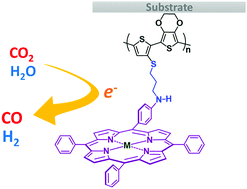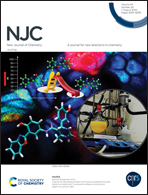Efficient heterogeneous catalysis by pendant metalloporphyrin-functionalized polythiophenes for the electrochemical reduction of carbon dioxide†
Abstract
In this work, two novel ZnII- and CoII-porphyrin monomers with thiophene-based units attached via flexible 1,3-aminothiopropylene linkers were successfully synthesized and fully characterized. Electropolymerization of these monomers was performed on indium tin oxide (ITO)-coated glass and carbon paper via cyclic voltammetry (CV) to obtain the corresponding polymer films for photophysical characterization and investigation of their catalytic activities for the electrochemical reduction (ECR) of carbon dioxide (CO2), respectively. CV and controlled potential electrolysis (CPE) in a 0.5 M KHCO3 aqueous solution showed that the ZnII-porphyrin-based polymer mainly supports hydrogen (H2) evolution from water splitting, while the CoII-porphyrin-based polymer predominately promotes the formation of carbon monoxide (CO). At a reduction potential of −0.66 V vs. reversible hydrogen electrode (RHE), equivalent to an overpotential of −0.54 V, CPE under the catalysis of the CoII-porphyrin-based polymer could efficiently convert CO2 to CO with the optimum faradaic efficiency, turnover number (TON) and turnover frequency (TOF) of 66%, 5.7 × 102 and 1.6 s−1, respectively, after 1 h. The 6 h CPE suggests satisfactory film stability and steady production of CO from the ECR of CO2, indicating the potential use of this polymer film for the reduction of CO2 at a low overpotential under ambient conditions in aqueous media.



 Please wait while we load your content...
Please wait while we load your content...